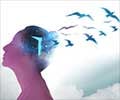Researchers say a primitive region of the brain, which is behind sensorimotor control, also plays an important role in regulating emotional responses to threatening situations.
This region appears to work in concert with another structure called the amygdala to regulate social and emotional behavior.The researchers at Georgetown University Medical Center have recently discovered that activation of a primitive brain region, the deep layers of superior colliculus (DLSC), elicits defensive behaviors such as an exaggerated startle, hypervigilance, cowering, and escape.
They have said that a prolonged activation of this defense system may lead to emotional disorders.
The researchers said that in addition to triggering defensive behaviors, the activation of DLSC leads to a decrease in affiliative social interactions.
Typically, social interactions are thought to be domain of the amygdala, a region known to work closely with high-level executive structures to regulate emotional processes.
They have said that there is no information about possible interactions between the amygdala and DLSC for regulating social and emotional responses.
Advertisement
"These results suggest that the amygdala and DLSC interact to modulate emotional and social behaviors, either directly, or indirectly by converging on a common target in the brain.
Advertisement
The study was presented at the 39th annual meeting of the Society for Neuroscience.
Source-ANI
ARU












